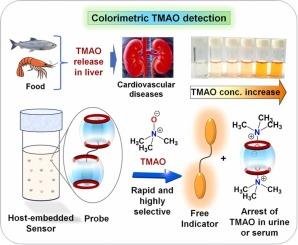Highly Sensitive Host-embedded Supramolecular Colorimetric Trimethylamine N-Oxide Sensor in Urine and Serum Environment
IF 3.7
1区 化学
Q1 CHEMISTRY, ANALYTICAL
引用次数: 0
Abstract
Trimethylamine N-oxide (TMAO) a crucial biomarker associated with the cardiovascular diseases (CVD), one of the common causes for worldwide deaths, thereby necessitating its accurate quantification in biological fluids for early diagnosis and disease management. Herein, for the first time a water-soluble supramolecular probe based on a host–guest chemistry between cucurbit[6]uril (CB6) and a styrylpyridine derivative (Spy), referred as Spy@CB6, was used for the colorimetric detection of TMAO in physiologically relevant matrices, including urine and human serum. The Spy@CB6 complex functions through an indicator displacement assay (IDA) mechanism, wherein TMAO efficiently displaces the Spy dye from their host-guest complexes by forming a stronger inclusion complex with CB6, resulting in distinct optical changes. This binding event enables highly sensitive detection, with low limit of detection (LOD) of 28.7 nM in urine and 7.4 nM in human serum, within clinically relevant ranges. The probe exhibits remarkable selectivity toward TMAO over ten common biological interferents and further demonstrates solid-state colorimetric responsiveness in urinated samples, highlighting its potential for point-of-care diagnostics. This work sets a new benchmark for highly sensitive TMAO detection in real biological matrices within clinically relevant concentration ranges and represents a significant advancement toward non-invasive, accessible, and patient-friendly diagnostic platforms.

尿液和血清环境中高灵敏度宿主嵌入超分子比色三甲胺n -氧化物传感器
三甲胺n -氧化物(TMAO)是与心血管疾病(CVD)相关的重要生物标志物,是全球死亡的常见原因之一,因此有必要在生物体液中对其进行准确定量,以进行早期诊断和疾病管理。本文首次采用一种基于葫芦[6]uril (CB6)和苯基吡啶衍生物Spy (Spy@CB6)之间主客体化学的水溶性超分子探针,用于生理相关基质(包括尿液和人血清)中TMAO的比色检测。Spy@CB6配合物通过指示剂置换试验(IDA)机制起作用,其中TMAO通过与CB6形成更强的包合物有效地将Spy染料从其主客体配合物中置换,从而导致明显的光学变化。该结合事件可实现高灵敏度检测,尿液和人血清的低检出限(LOD)分别为28.7 nM和7.4 nM,在临床相关范围内。该探针对TMAO的选择性超过了10种常见的生物干扰,并进一步证明了尿液样品的固态比色响应性,突出了其在即时诊断方面的潜力。这项工作为在临床相关浓度范围内的真实生物基质中进行高灵敏度的TMAO检测设定了新的基准,并代表了向非侵入性,可获取和患者友好的诊断平台的重大进展。
本文章由计算机程序翻译,如有差异,请以英文原文为准。
求助全文
约1分钟内获得全文
求助全文
来源期刊

Sensors and Actuators B: Chemical
工程技术-电化学
CiteScore
14.60
自引率
11.90%
发文量
1776
审稿时长
3.2 months
期刊介绍:
Sensors & Actuators, B: Chemical is an international journal focused on the research and development of chemical transducers. It covers chemical sensors and biosensors, chemical actuators, and analytical microsystems. The journal is interdisciplinary, aiming to publish original works showcasing substantial advancements beyond the current state of the art in these fields, with practical applicability to solving meaningful analytical problems. Review articles are accepted by invitation from an Editor of the journal.
 求助内容:
求助内容: 应助结果提醒方式:
应助结果提醒方式:


